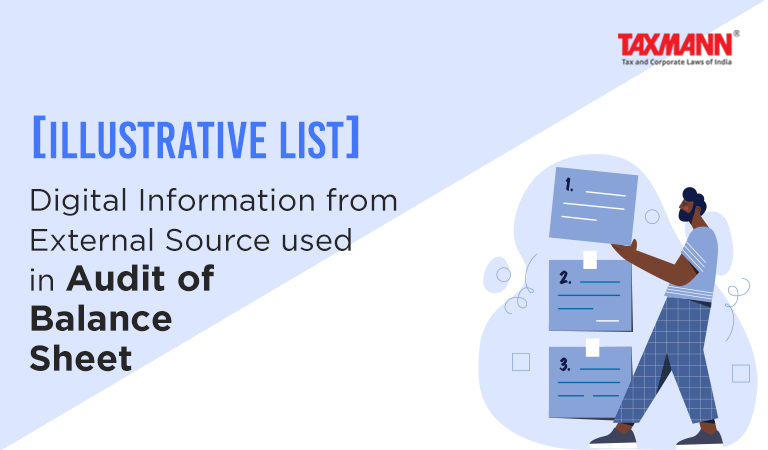[Illustrative List] Digital Information from External Source used in Audit of Balance Sheet
- Blog|News|Account & Audit|
- 2 Min Read
- By Taxmann
- |
- Last Updated on 25 March, 2023

An auditor may use digital information from external sources across various phases of the audit. Standards on Auditing (SAs) require an auditor to obtain sufficient appropriate audit evidence to be able to draw reasonable conclusions on which to base the auditor’s opinion. With the emergence of new technology has enabled auditors to access a wider range of external information than before.
Digital information can be incorporated into the audit process, and sometimes it can be compared and matched with internal evidence. An auditor may use digital information from external sources across various phases of the audit. In many cases, the auditor is also able to use internal evidence and reconcile/ map them to the external data. Certain examples of cases of how electronic/digital information from external sources can be used in audits for processes related to the Balance Sheet are discussed in this story.
I. Procure to pay – GST Input tax credit:
a. Background: GST Input Tax Credit is the process of claiming the credit of the GST paid on the purchase of goods and services which are used for the furtherance of business. To extract details corresponding to a GSTIN from any publicly available websites and to check for inaccuracies with regards to incorrect HSN codes, fictitious GSTINs, incorrect credits, etc.
b. Data Source: The following data sets are required
-
- GSTIN details from GST portal (External evidence – Government authorised site)
- Vendor master having the GST details and GSTIN (Internal evidence books of accounts)
c. Use Case: Auditor can identify fictitious GSTINs in the vendor master wherein no details of such GSTINs are available on the GST portal. Similarly, Auditor can also identify cancelled and suspended GSTINs from the portal. We can tie back the transactions for fictitious GSTINs, cancelled & suspended GSTINs and input credit for those transactions will be disallowed.
d. Stage in audit: Execution – Overall comfort with the GST Input tax credit
e. Accounts & Assertions: GST Input tax credit – Existence, Valuation, Rights & Obligation
f. Links: https://services.gst.gov.in/services/login
This story discusses in tabular manner detail including Background, Data source, Use-case, Stage in audit, Accounts and assertions, and links for the following also.
II. Ownership and License Details of MEIS/ SEIS/ RoSCTL
III. Wilful Defaulter Testing
IV. Conversion of foreign exchange into INR
V. Procure to pay – identifying struck-off companies and other company details
VI. Sales process recoverability of debts
Click Here To Read The Full Story
Disclaimer: The content/information published on the website is only for general information of the user and shall not be construed as legal advice. While the Taxmann has exercised reasonable efforts to ensure the veracity of information/content published, Taxmann shall be under no liability in any manner whatsoever for incorrect information, if any.

Taxmann Publications has a dedicated in-house Research & Editorial Team. This team consists of a team of Chartered Accountants, Company Secretaries, and Lawyers. This team works under the guidance and supervision of editor-in-chief Mr Rakesh Bhargava.
The Research and Editorial Team is responsible for developing reliable and accurate content for the readers. The team follows the six-sigma approach to achieve the benchmark of zero error in its publications and research platforms. The team ensures that the following publication guidelines are thoroughly followed while developing the content:
- The statutory material is obtained only from the authorized and reliable sources
- All the latest developments in the judicial and legislative fields are covered
- Prepare the analytical write-ups on current, controversial, and important issues to help the readers to understand the concept and its implications
- Every content published by Taxmann is complete, accurate and lucid
- All evidence-based statements are supported with proper reference to Section, Circular No., Notification No. or citations
- The golden rules of grammar, style and consistency are thoroughly followed
- Font and size that’s easy to read and remain consistent across all imprint and digital publications are applied



 CA | CS | CMA
CA | CS | CMA
